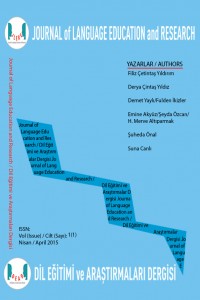Abstract
A causal relation is considered as the most important element which provides coherence in both written and oral texts, and in complex sentences which are constructed by the use of particular converbs may have a closer subjective relation –to what extend the speaker/writer involves himself/herself to the causal relation- than other converbs which also have causal implications. In this study, three Turkish converbs, –IncA, - DIĞI için and –DIĞINA göre, which can convey volitional causal relations are taken into consideration in terms of the subjectivity levels observed in the complex sentences. Nearly 600 complex sentences –obtained from WebCorp- are analyzed with regards to the propositional content of the main clause, the type of causal relationship, the type of conceptualizer and the linguistic realization of the conceptualizer. Frequency distributions of these converbs highlight that the converbs can be scaled according to the subjectivity level of the complex sentences that they are used in.
Keywords: converb, causal relation, subjectivity, complex sentenceReferences
- Çetintaş Yıldırım, F. (2010). Türkçede belirteç tümcecikleri: Sözdizimsel yapı çözümlemesi çerçevesinde bir sınıflandırma önerisi. Unpublished PhD Thesis, Ankara University, Ankara
- Finegan, E. (1995). Subjectivity and subjectivisation: An introduction. In, D. Stein & S. Wright (Eds.). Subjectivity and subjectivisation (pp. 1-15). Cambridge: CUP
- Degand, L. (1998). On classifying connectives and coherence relations. Retrieved May 27, 2009, from http://www.ldc.upenn.edu/acl/W/W98/W98-0305.pdf
- Degand, L. & Pander Maat, H. (2003). A Contrastive study of Dutch and French causal connectives on the speaker involvement scale. In, A. Verhagen & J. Van der Weijer (Eds.). Usage- based approaches to Dutch (pp. 175-200). Utrecht:LOT
- Kehler, A. (2002). Coherence, reference, and the theory of grammar. Stanford: CSLI Publications
- Meyer, P. G. (2000). The relevance of causality. In, E. Couper-Kuhlen &B. Kortmann (Eds.). Cause, condition, concession, contrast (pp. 143-172). Berlin: Mouton de Gruyter
- Sanders, T. J. M. (2005). Coherence, causality and cognitive complexity in discourse. Retrieved February sem05/proceedings-final/03-Sanders.pdf from
- http://w3.erss.univtlse2.fr/textes/pagespersos/bras/
- Sanders, T. & Pander Maat, H. (2006). Cohesion and coherence: Linguistic approaches. Retrieved November 28, uploads/pdf/Sanders%20Pander%20Maat%20(2006).pdf 2008, from
- http://www.let.uu.nl/̴Ted.Sanders/personal/
- Spooren, W. and et al. (2007). Subjectivity and causality: A Corpus study of spoken language. Retrieved SpoorenetalSubjectivityandCausalty_tcm10-57600.pdf 15, 2009, from
- http://www.let.vu.nı/nl/Images/
- Stukker, N. & Sanders, T. (2008). Another(‘s) perspective on subjectivity in clausal connectives: Analyzing typical and non-typical use in corpora. In, W. Ramm & C. Fabricius-Hansen (Eds.). Linearisation and segmentation in discourse (pp. 113-122). Oslo: University of Oslo
- Sweetser, E. (1990). From etymology to pragmatics: Metaphorical and cultural aspects of semantic structure. Cambridge: Cambridge University Press
- Uslu, Z. (2001). Türkçede neden bildirme işlevi: ‘İçin ilgeci ve ‘-dAn’ eki. In, Ö. Demircan & A. Erözden (Eds.). XV. dilbilim kurultayı: Bildiriler (pp. 123-130). İstanbul: Yıldız Teknik University
Abstract
Neden ilişkileri, hem yazılı hem de sözlü metinlerde bağdaşıklığı sağlayan en önemli unsur olarak düşünülmektedir. Kimi ulaç eklerinin kullanımıyla kurulan karmaşık tümcelerde, benzer nedensel sezdirimleri olan diğer ulaç eklerine göre daha yakın bir öznel ilişki – konuşucu/yazar kendi öznel görüşünü kurulan nedensel ilişkinin içine ne kadar koyuyor- olduğu görülebilir. Bu çalışmada, istemli nedensel ilişkiler kuran üç Türkçe ulaç eki, –IncA, - DIĞI için and –DIĞINA göre, karmaşık tümcelerde görülen öznellik düzeylerine göre inceleme kapsamına alınmaktadır. WebCorp veri tabanından taranan yaklaşık 600 karmaşık tümce, temel tümceciğin önermesel içeriği, aktarılan nedensel ilişkinin türü, tümcedeki kavramsallaştırıcının türü ve kavramsallaştırıcının dilbilgisel gerçekleşmesi bakımlarından çözümlenmektedir. Sözü edilen ulaç eklerinin sıklık dağılımları, bu ulaç eklerinin, içinde kullanıldıkları karmaşık tümcelerin öznellik düzeylerine göre belirli bir sıradüzene sokulabileceğini göstermektedir
Keywords
References
- Çetintaş Yıldırım, F. (2010). Türkçede belirteç tümcecikleri: Sözdizimsel yapı çözümlemesi çerçevesinde bir sınıflandırma önerisi. Unpublished PhD Thesis, Ankara University, Ankara
- Finegan, E. (1995). Subjectivity and subjectivisation: An introduction. In, D. Stein & S. Wright (Eds.). Subjectivity and subjectivisation (pp. 1-15). Cambridge: CUP
- Degand, L. (1998). On classifying connectives and coherence relations. Retrieved May 27, 2009, from http://www.ldc.upenn.edu/acl/W/W98/W98-0305.pdf
- Degand, L. & Pander Maat, H. (2003). A Contrastive study of Dutch and French causal connectives on the speaker involvement scale. In, A. Verhagen & J. Van der Weijer (Eds.). Usage- based approaches to Dutch (pp. 175-200). Utrecht:LOT
- Kehler, A. (2002). Coherence, reference, and the theory of grammar. Stanford: CSLI Publications
- Meyer, P. G. (2000). The relevance of causality. In, E. Couper-Kuhlen &B. Kortmann (Eds.). Cause, condition, concession, contrast (pp. 143-172). Berlin: Mouton de Gruyter
- Sanders, T. J. M. (2005). Coherence, causality and cognitive complexity in discourse. Retrieved February sem05/proceedings-final/03-Sanders.pdf from
- http://w3.erss.univtlse2.fr/textes/pagespersos/bras/
- Sanders, T. & Pander Maat, H. (2006). Cohesion and coherence: Linguistic approaches. Retrieved November 28, uploads/pdf/Sanders%20Pander%20Maat%20(2006).pdf 2008, from
- http://www.let.uu.nl/̴Ted.Sanders/personal/
- Spooren, W. and et al. (2007). Subjectivity and causality: A Corpus study of spoken language. Retrieved SpoorenetalSubjectivityandCausalty_tcm10-57600.pdf 15, 2009, from
- http://www.let.vu.nı/nl/Images/
- Stukker, N. & Sanders, T. (2008). Another(‘s) perspective on subjectivity in clausal connectives: Analyzing typical and non-typical use in corpora. In, W. Ramm & C. Fabricius-Hansen (Eds.). Linearisation and segmentation in discourse (pp. 113-122). Oslo: University of Oslo
- Sweetser, E. (1990). From etymology to pragmatics: Metaphorical and cultural aspects of semantic structure. Cambridge: Cambridge University Press
- Uslu, Z. (2001). Türkçede neden bildirme işlevi: ‘İçin ilgeci ve ‘-dAn’ eki. In, Ö. Demircan & A. Erözden (Eds.). XV. dilbilim kurultayı: Bildiriler (pp. 123-130). İstanbul: Yıldız Teknik University
Details
| Primary Language | English |
|---|---|
| Journal Section | Research Articles |
| Authors | |
| Publication Date | May 6, 2015 |
| Submission Date | November 7, 2015 |
| Published in Issue | Year 2015 Volume: 1 Issue: 1 |
________________________________________________
Journal of Language Education and Research (JLERE)
Dil Eğitimi ve Araştırmaları Dergisi
https://dergipark.org.tr/en/pub/jlere
ISSN: 2149-5602
Facebook Grup
Copyright © Journal of Language Education and Research


